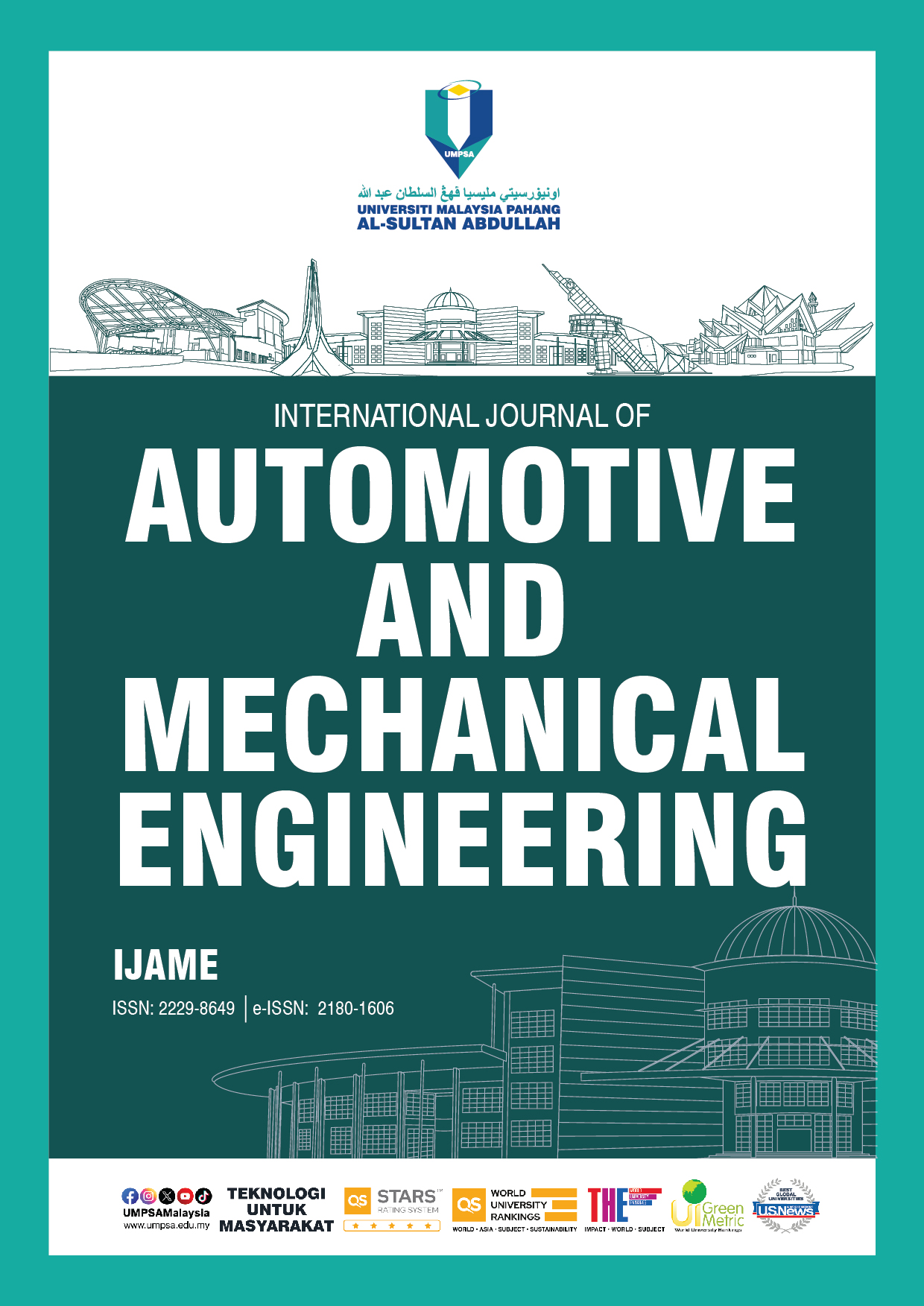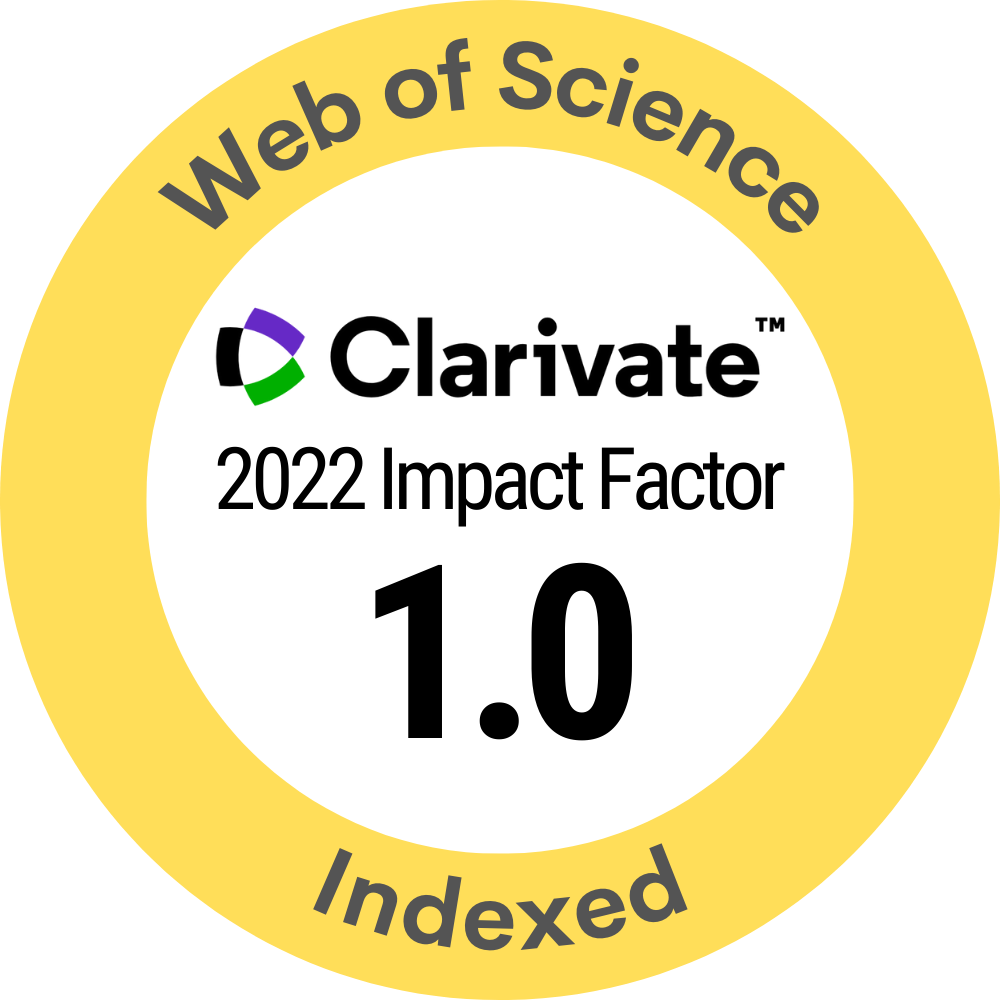Vehicle Driving State Recognition and Test Analysis Using Vehicle Body Attitude Measurement and One-Dimensional Convolutional Neural Network
DOI:
https://doi.org/10.15282/ijame.22.2.2025.2.0939Keywords:
Car driving recognition, 1D-CNN, Vibration accelerationAbstract
The increase in the number of cars on the road has led to frequent traffic accidents, some of which may be due to human factors such as poor driving habits. In order to reduce the number of accidents, there is a need to accurately analyze the driver's driving behavior and accurately identify the actual state of motion of the car. A method based on a one-dimensional convolutional neural network to determine the condition of a vehicle is proposed. Vibration acceleration indications for four different fuel-powered vehicle traveling states (constant speed, acceleration, deceleration, acceleration and deceleration) and six electric vehicle driving states (constant driving, acceleration, deceleration, acceleration and deceleration, left-turn driving, and right-turn driving) were measured using GPS inertial navigation sensors. New data samples are then extracted and evaluated to cover the full range of each operational situation. Access to the "keras" package via Python allows the creation of a one-dimensional Convolutional Neural Network (1D-CNN) model. The model receives one-dimensional vibration acceleration signals as input for parameter tuning. The experimental results show that the application of multimodal data fusion in automotive driving state recognition is achieved by combining vehicle attitude signals with the 1D-CNN method and GPS navigation data. This approach features high recognition accuracy, strong generalization ability, short model training time, and high reliability, with the model achieving a training accuracy of 90%. It is aimed at monitoring driver behavior and optimizing driver assistance systems, while also providing new ideas and methods for improving the performance and safety of automatic navigation and autonomous driving systems.
References
[1] D. Li, “Research on Vehicle Speed Status and Driving Behavior Safety Based on Data Features,” Ph.D. dissertation, Northeast Forestry University, 2021.
[2] M. Zhuang, H. Bai, and X. Xie, “Analysis of risky driving behavior and related factors among drivers,” Journal of Peking University (Natural Science Edition), vol. 44, no. 3, p. 475 - 482, 2008.
[3] C. Miyajima, Y. Nishiwaki, K. Ozawa, T. Wakita, K. Itou, K. Takeda, et al., “Driver modeling based on driving behavior and its evaluation in driver identification,” Proceedings of the IEEE, vol. 95, no. 2, pp. 427–437, 2007.
[4] C. Tran, A. Doshi, and M. M. Trivedi, “Modeling and prediction of driver behavior by foot gesture analysis,” Computer Vision & Image Understanding, vol. 116, no. 3, pp. 435–446, 2012.
[5] C. Tran, A. Doshi, and M. M. Trivedi, “Pedal error prediction by driver foot gesture analysis: A vision-based inquiry,” in 2011 IEEE Intelligent Vehicles Symposium (IV), Baden-Baden, Germany, 2011, pp. 565–570.
[6] C. He, “Recognition and Optimization of Automotive Driving Behavior Based on the State of the Car,” Ph.D. dissertation, Tsinghua University, 2014.
[7] H. Song, “Modeling method for driving behavior of intelligent connected vehicles based on accelerometers,” Mobile Communications, vol. 43, no. 5, pp. 45–50, 2019.
[8] W. Guo, “Research on Automobile Driving Behavior in Virtual Complex Traffic Scenarios,” Ph.D. dissertation, Hubei University of Technology, 2020.
[9] Z. Li, J. Han, X. Zhao, M. Zhu, and W. Dong, “Comparative analysis of drunk driving recognition methods based on K-nearest neighbors and support vector machines,” Transportation Systems Engineering and Information, vol. 15, no. 5, pp. 246–251, 2015.
[10] N. Wang, Z. Zhou, Y. Zhao, H. Guo, and J. Chen, “Research on real-time fatigue driving detection and warning based on wireless EEG signal analysis,” Journal of Taiyuan University of Technology, vol. 51, no. 6, pp. 852–859, 2020.
[11] X. Zhai, “Research on HMM Based Random Driver Fatigue State Identification,” Ph.D. dissertation, Dalian University of Technology, 2019.
[12] Y. Xing, C. Lv, X. Mo, Z. Hu, C. Huang, and P. Hang, “Toward safe and smart mobility: energy-aware deep learning for driving behavior analysis and prediction of connected vehicles,” IEEE Transactions on Intelligent Transportation Systems, vol. 22, no. 7, pp. 4262–4274, 2021.
[13] H. Yang, “Research on Automotive Driving Behavior Based on Computer Vision,” Ph.D. dissertation, Taiyuan University of Technology, 2020.
[14] Y. Leyue, “Research on Vehicle Behavior Recognition and Detection Based on Deep Learning,” Ph.D. dissertation, Hefei University of Technology, 2019.
[15] Y. Guo, “Research on Vehicle Driving State Recognition Algorithm Based on Deep Learning,” Ph.D. dissertation, Beijing University of Posts and Telecommunications, 2019.
[16] N. Zhou, “Research on Fatigue Driving State Recognition Based on Neural Networks,” Ph.D. dissertation, China University of Mining and Technology, 2020.
[17] C. Du, R. Zhong, Y. Zhuo, X. Zhang, F. Yu, F. Li, et al., “Research on fault diagnosis of automobile engines based on the deep learning 1D-CNN method,” Engineering Research Express, vol. 4, no. 1, p. 015003, 2022.
[18] Y. Huang, C. Gu, and H. Yang, “The strategy of deleting garbage neurons for neural network hyperparameter optimization,” Acta Physica Sinica, vol. 71, no. 16, p. 160501, 2022.
[19] D. Chen, Y. Chen, X. Feng, and S. Wu, “Remote sensing inversion of river suspended matter concentration based on hyperparameter optimized CatBoost algorithm,” Journal of Earth Information Science, vol. 24, no. 4, pp. 780-791, 2022.
[20] J. Qu, L. Yu, T. Yuan, Y. Tian, and F. Gao, “Adaptive fault diagnosis algorithm for rolling bearings based on one-dimensional convolutional neural network,” Journal of Instruments and Meters, vol. 39, no. 10, pp. 1–8, 2018.
[21] Y. He, C. Quan, K. Wei, J. Feng, Y. Wan and S. Chen, “Vehicle coordinate transformation model of superhighway virtual track system,” Journal of Shandong University (Engineering Edition), vol. 53, no. 4, pp. 56–64, 2023.
[22] G. -S. Lee, “Machine learning-based driving style classification real-world data prediction,” 2024 4th International Conference on Artificial Intelligence, Robotics, and Communication (ICAIRC), Xiamen, China, 2024, pp. 53-57.
[23] T. Zhang, H. Liu, W. Wang and X. Wang, “Virtual tools for testing autonomous driving: A survey and benchmark of simulators datasets and competitions,” Electronics, vol. 13, no. 17, pp. 3486, 2024.
[24] Y. Bo, X. Jia, H. Guan and H. Wang, “Vehicle directional driving behavior segmentation based on cornering strength,” in IEEE Access, vol. 12, pp. 69172-69187, 2024.
[25] F. Nowshin, S. Sethi, Z. Dong and Y. Yi, “Enhancing driving behavior analysis in autonomous systems: A reservoir computing and temporal-aware machine learning approach,” 2024 IEEE International Conference on Mobility, Operations, Services and Technologies (MOST), Dallas, TX, USA, 2024, pp. 24-33.
[26] L. Chen, Y. Li, C. Huang, Y. Xing, D. Tian, L. Li, et al., “Milestones in autonomous driving and intelligent vehicles—part i: Control computing system design communication hd map testing and human behaviors,” IEEE Transactions on Systems Man and Cybernetics: Systems, vol. 53, no. 9, pp. 5831-5847, 2023.
[27] H. M. Abdelghaffar, M. Chaqfeh, N. Fejzic, T. Rahwan, Y. Zaki and M. Menendez, “Leveraging autonomous vehicles to tally cooperative driving behavior,” in IEEE Access, vol. 11, pp. 25455-25466, 2023.
[28] M. S. Devi and R. Ranjani, “Logistic multilayer perceptron neural network classification based driving behavior prediction through vehicle motion data,” 2023 Third International Conference on Advances in Electrical, Computing, Communication and Sustainable Technologies (ICAECT), Bhilai, India, 2023, pp. 1-5.
[29] S. Takatera, K. Funahashi, K. Tanida and S. Mizuno, “Psychological analysis of right-turn driving behavior for development of autonomous vehicles,” 2024 Joint 13th International Conference on Soft Computing and Intelligent Systems and 25th International Symposium on Advanced Intelligent Systems (SCIS&ISIS), Himeji, Japan, 2024, pp. 1-4.
[30] J. Du, J. Wang, J. Chen, X. Ding, J. Wu, T. Hu and H. Ma, “Analyzing behavior and intention in multi-agent systems using graph neural networks,” 2024 IEEE International Conference on Multimedia and Expo (ICME), Niagara Falls, ON, Canada, 2024, pp. 1-6.
[31] A. A. Pande, P. S. Wawage and Y. D. Deshpande, “Driver Behaviour Classification using Neural Networks,” 2024 4th Asian Conference on Innovation in Technology (ASIANCON), Pimari Chinchwad, India, 2024, pp. 1-5.
Downloads
Published
Issue
Section
License
Copyright (c) 2025 The Author(s)

This work is licensed under a Creative Commons Attribution-NonCommercial 4.0 International License.







